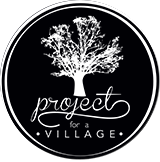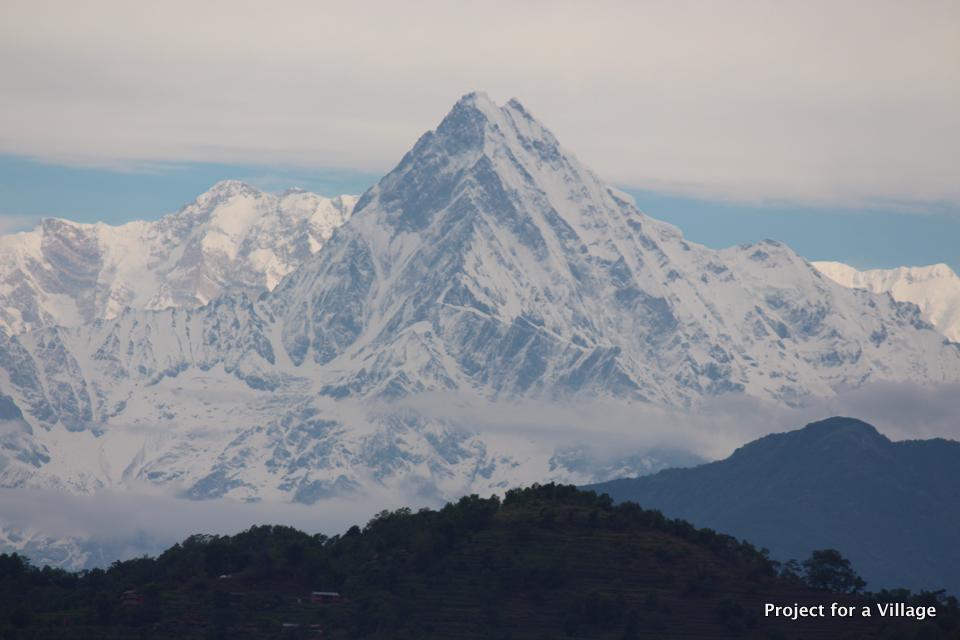We caught a bus in the afternoon to Kunchha (about an hour away), had some lunch, and began the walk up to Bijaya’s mama’s (maternal uncle’s) village, Pulimarang. The walk wasn’t too eventful, along the way we met up with a couple from that same village and walked together with them. It started raining as we got about half of the way there, which brings a nice cool air, but also brings out more leeches. Of course one found me. Bijaya pulled it off, but the blood doesn’t stop. Although the first time I came to Nepal some of the village boys showed me that after a leech bites, if you put a certain leaf on it, it stops bleeding right away. There are so many natural cures/solutions here.
We arrived in Pulimarang around 6pm and started walking down the village’s main path which is a staircase lined with beautiful stone walls. I always say when I’m here that Pulimarang really knows their stones. Everywhere you look there are perfectly placed stones making walls, paths and houses. This village is also primarily Gurung people and the houses are all very close together with all the houses coming off the center stone staircase, as I call it. Almost every house there has a beehive made from large logs hanging from the side of the homes to collect honey. I have noticed that this village, in particular, many people take time to decorate their home with potted flowers, many not having actual pots, but using old cans, bottles and buckets to plant them in.
Many people here speak the Gurung language to each other, instead of Nepali. Bijaya was born in this village, and grew up there until he was ready to go to school. At that age he only knew Gurung language, no Nepali at all. When he went back to his village to go to school it was very difficult at first as everything was taught in Nepali. Nowadays there are fewer and fewer places in Nepal where their ethnic languages are still spoken. The ethnic Gurung language is so hardly used and spoken that it appears in the coming generations it might be a lost language forever. We walked down to Bijaya’s mama’s house, passing and saying hello to other neighbors along the way. In this village, since it is his mama’s village Bijaya calls most of the men “Mama,” and women, “Maiju” (maternal uncle’s wife). One very different thing in Nepali culture is so few people call each other by their actual names. Instead, it’s all about relationships. If you are talking to a woman who looks to be in your same generation, but older than you, you should call her Didi (older sister), and if a little younger than you, Bahini (younger sister). Anyone who is older, and similar age to your grandparents, you should call Baja (grandpa) or Buju (grandma)- these terms are specifically for the Gurung caste, there are other words for grandparents in Nepali. However, it gets even more complicated, sometimes your relation is a nephew, sometimes just a friend (Sati), sometimes a sister-in-law, daughter-in-law. So many people don’t even know their own grandchild’s name, or good friend’s name, or aunt’s name. In Nepali there are different words for your birth order. For example, people call Maila (second born son) or Kanchhi (youngest daughter) without an actual name attached. You always need to be aware of who you are talking to and find the correct relation to call them. It gets complicated, especially for me!
When we arrived at Bijaya’s mama’s house his youngest uncle, aunt and grandma were there to greet us. They were very happy to see us and we talked and drank a little local wine that night. His grandma has not been well for the last three years or so, she has so much back and body pain that she can basically no longer move her lower half. Living in the village with a problem like that, means you hardly move at all, she can only just lay down the entire day. When we got there, she was sleeping, but after a couple hours she woke up and we went in to say hello to her. She then tied around the same yellow string to welcome us home as we had received in both the village and Sundar Bazar. That night it POURED, which was good news for the corn crop – which has been so desperate for rain.
We stayed just one night, and woke up the next morning to a beautiful view of a snow-capped mountain range. It’s so interesting in so many places in Nepal you are constantly surrounded by hill range after hill range, stretching as far as the eye can see. However, sometimes you get a pleasant surprise and the air is finally light, and it lifts the humidity and clouds away, and suddenly huge snow-capped mountains seem to appear out of nowhere. That’s what happened that morning, after the heavy rain, it cleared the air and we had a beautiful view! I often forget that the mountains are always right there, just almost always out of sight. We took lots of photos before the clouds drifted in and once again hid the mountains from view as they always do.
We drank milk tea in the morning and were sitting outside when we heard Bijaya’s grandma yelling from inside where she was laying down. His aunt rushed in, and soon his uncle too- his grandma seemed to be in a panic. Then she was quiet and out his uncle came carrying a baby mouse – which had been crawling on his grandma. She was so scared not knowing what it was and not being able to move. Baby mice are sneaky, and in my opinion more annoying than adult mice. The first year I was in Nepal I was taking a nap on my day off, lying on my stomach I woke up suddenly when something fell on my back. I could always hear the mice running around constantly in the ceiling – however I never expected one to fall on me. It turns out, there’s never just one baby mouse, as I learned. Over the next couple of weeks I would find them stuck in my pile of clothes, running under and across my bed. The sneakiest baby mouse of all though, was the one who crawled into my bag right before I was leaving Nepal. I didn’t know, until I was back in America, dumped out my bag on the floor, came back in my room and found a tiny little Nepali mouse staring at me. He clearly wasn’t in good shape, but was trying to live out the American dream. I somehow had brought him all the way home (not on purpose, trust me!) After eating, we took some photos of his grandma, uncle and aunt. That morning his uncle had carried out his grandma so that she could lie on the cot outside.
Right before we were about to leave, his aunt warned us that we should give some money to two women whose house’s we were passing by to leave. I asked why, and she was explaining how so many people lately think that they are witches. Therefore to avoid any bad spell or bad spirits following us, his aunt told us we should say goodbye to them and be nice and give them money so that hopefully we can avoid any bad situation. That’s advice – which sounds crazy, but still it’s difficult not to believe it at all. So Bijaya gave them both a little money, just to be safe! We walked the same path down, but then had to walk back to Sundar Bazar since no bus goes that direction after 10am. Along the way we met some people who I’ve known throughout my time in Nepal, so it was great to be able to seem them, even if only for a short hello and goodbye. Coming back after two years, it was interesting to see all the changes, new houses being built, kids going to different schools, people having new babies, life is always moving so fast!




